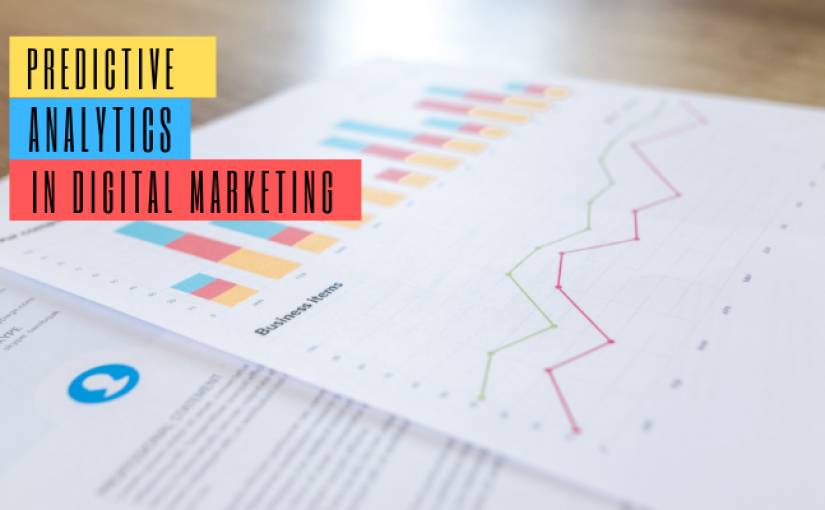As a savvy marketer in the digital age, you always need to stay up-to-date on the latest advancements in the world of technology, business intelligence, and analytics. You need to find better ways to refine your target audience with the help of your digital marketing campaigns. Predictive analysis tells you how to turbo charge your digital marketing strategy. In fact, predictive analysis will make this marketing strategy possible.
Want to learn how you can turbocharge your marketing campaigns? We will explore the use of predictive analytics in digital marketing. You’ll know what predictive analytics are and what you can do with it. Best of all, you’ll learn why you need to use this data and what lies in the future beyond 2019.
What is Predictive Analytics for Marketing?
Predictive Analytics is a branch of Analytics that requires “the use of big data and statistical algorithms along with machine learning techniques in order to identify the future likelihood of outcomes based on the available historical data,” according to SAS.
If you refer to the explanation by Salesforce: “Predictive marketing relies on data science to come up with accurate predictions for making marketing decisions and to plan marketing strategies that are most likely to succeed in the future.”
Simply put, it involves any analytical activity that leverages the existing customer data for making intelligent assumptions about the future activity of potential customers.
Significance of Predictive Analytics for Businesses
By now you have probably realized that predictive analysis in digital marketing can potentially help you make a really good use of the existing historical data you may already have sitting around somewhere. Want to know how many marketers are already using it for growing their business?
91% of professional marketers are either already fully committed to or are in the process of implementing predictive marketing for better results, according to a research study conducted by Salesforce.
Here’s why businesses are using predictive analysis to achieve better results with marketing than ever before.
-
Accurate Prediction of Customer Behavior
Needless to say, customer intelligence is the prime focus in the marketing game. The better you understand your customers, for example, where they visit their time, what do they want and when they want it the easier it becomes to reach them across various marketing channels.
For instance, the predictive analysis also assist in determining the rate of engagement that people show on social media channels which could further help marketers to plan a time-saving social media strategy. Don’t just save time — remember to keep your data safe, as well.
-
Optimized Lead Generation and Sales Efforts
Unqualified leads usually end up costing companies a lot of their time and money. With the help of predictive analytics, you can devise an algorithm that qualifies leads by prioritizing those who are known prospects based on their likelihood of taking action. You can derive insights from it to help your sales team focus on and nurture only the most profitable segment of customers.
-
Personalized Messaging
If you have been interacting with business online, you already know that personalization matters more than ever. Predictive analytics is the missing link for most businesses.
It can help with instant automated audience segmentation for delivering highly personalized messaging, which means you can better target specific segments, groups or individuals when you’re trying to cross-sell, up-sell, or recommend other products. As you can guess, possibilities are virtually endless.
-
Bringing Better Products or Services to the Market
Perhaps you already know how valuable data visualization can be when it comes to inspiring and guiding your business decisions based on customer behavior data.
But what sources of data can you trust for making business decisions about improving your existing range of products/services, or launching new products/services – predictive analytics or just a handful of personal opinions? Of course, the former!
Various Predictive Models and Their Applications
In this section, we will take a look at five of the most commonly used predictive modeling techniques. They can be classified under three broad categories:
- Intelligent Recommendations
- Propensity Models
- Segmentation Models
Category #1: Intelligent Recommendations
Technique #1: Recommendations Filtering
If you want to create an opportunity for increasing revenue at the point of sale, try this model. It’s similar to asking yourself, as a business owner, a crucial question: “What all upsell or cross-sell opportunities exist for this customer?” Amazon operates its business on this model by showing their customers a list of “recommended products” on each product page.
Category #2: Propensity Models
Technique #2: Share-of-Wallet Estimation
This model refers to how much budget the customer can allocate towards buying your solution. Needless to say, the higher the share-of-wallet, the lesser will be the likelihood of successful upsells or cross-sells.
Technique #3: Likelihood of Churn
For companies that sell memberships or subscriptions, the churn rate can be a major problem. But if you can accurately predict the likelihood of a lead converting to a new customer, similarly you can accurately predict the likelihood of them canceling their subscription, for example.
Category #3: Segmentation Models
Technique #4: Behavioral Clustering
When you combine behavioral data with demographic data, for example, it can help your digital marketing team to derive valuable insights to improve conversions and also accurately forecast the results of their marketing campaigns.
Technique #5: Product-Based Clustering
Just like behavioral clusters, product-based clusters can help you identify customers who are likely to buy items from the same product category. It’s a nice idea to use this model not only to improve your sales figures but also to predict the lifetime value of customer accounts.
Implementation of Predictive Analytics in Digital Marketing
Want to reap the benefits of predictive analytics for marketing? Here’s how you too can do it.
-
Define Clear Goals
Make S.M.A.R.T goals – that are “specific”, highly “measurable”, very much within your reach or “achievable”, close to reality or “realistic”, and also “time-bound”.
-
Identify and Quantify Top Information Channels
Have you asked yourself the following questions?
- What are my top data sources?
- How can I best integrate multiple data channels to power up my analytics engine?
- How’s the workload of data clean-up going to be?
- What kind of data formats am I going to use?
- How much historical data do I already have ready to go?
-
Always Start Small
Keep in mind, you are just beginning to experiment with basic predictive analytics models in order to understand the challenges better, and to judge whether or not the results they deliver are reliable enough.
-
Re-calibrate and Scale Up
This step ensures that the results you are getting become more accurate and better with time. Accuracy will help you scale. There are three other ways tech can help you scale.
-
Combine Predictive Analytics with Digital Marketing
Utilize sophisticated predictive analytics tools that are specifically built for digital marketers and also offer intuitive modeling functionalities.
Predictive analytics can help digital marketers overcome several challenges. For example, in social media influencer marketing where locating quality influencers or micro-influencers for their business niche is quite intimidating, predictive tools help uncover the associations of complex social media and help fetch the right information. You may also decide to use nano-influencers to promote your brand.
Moreover, incorporating predictive analytics software in social media channels can provide varied insights of how users behave online and what are their preferences. This can help marketers forecast user behaviour for their future marketing endeavours.
-
Improve Customer Engagement
Understand how users interact and engage with your digital assets (like web pages) or ads on various devices with respect to time-of-day, CTAs, and content format.
-
Measure Digital Marketing ROIs Using Predictive Analytics
Predictive analytics models can track and capture user data, assign weights to each touch point across the sales funnel, and eventually calculate ROIs. Some have predicted that even Reddit could be the next big thing in marketing.
-
Create Accurate Customer Personas Using Behavior Data
By defining personas accurately, marketers can achieve significantly higher conversion rates by reaching the right customers through the right marketing channels.
The Future of Predictive Analytics in Digital Marketing
We are already seeing an upsurge in the availability of AI (artificial intelligence) powered marketing tools such as content curators, chatbots, and dynamic pricing models, among others.
In 2019 and beyond, we will see a rapid evolution of predictive analytics for use in digital marketing. Some of the following future prospects in this regard seem very appealing.
- Natural Language Processing (NLP)
Once capabilities like accurate detection of emotion and intent are within the reach of digital technology, marketers will be able to better use them for customer targeting and sales.
- In-memory Analytics and Big Data
As parallel processing of huge volumes of real-time data becomes more efficient than ever, marketers will be able to discover data, find statistical correlations and implement propensity modeling like never before.
- Machine Learning and Behavioral Science
Digital marketers have already started using machine learning algorithms in order to understand user behavior better. Through various engagement techniques like gamification, they will be able to refine segmentation and apply attribution modeling to significantly improve real-time outcomes from their digital marketing campaigns.
- IoT (Internet of things)
Every device around us will emit data and soon, digital marketers will be able to capture the customer behavior data in real-time.
- Email marketing
Email marketing tools will rely on predictive analytics to send emails at specific times of the day customized for each subscriber, in order to get higher open rates.
- Inside Sales and Lead Management Systems
With predictive analytics, it will become easier to mark the leads that are more likely to convert into buyers.
- Customer Support
If you want only a small percentage of users to reach out to your support department with their queries or issues, predictive analytics can come to the rescue.
Final Thoughts On Predictive Analytics in Digital Marketing
With the tech landscape evolving rapidly, companies that truly have the drive to succeed will let their digital marketing teams use the latest tools for making more informed decisions. This is how predictive analytics will give rise to a new paradigm – “Digital Marketing 2.0.” Having said this, access to clean, quality data is going to be imperative for gaining timely and accurate business intelligence.










